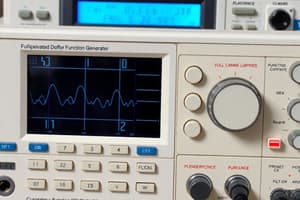Podcast
Questions and Answers
Which programming support is designed to keep programming fast and simple?
Which programming support is designed to keep programming fast and simple?
- Direct I/O SCPI (correct)
- VISA-COM Driver
- IVI-COM Driver
- IntuiLink software
What is the maximum number of points for arbitrary waveforms that can be created with the 33220A waveform generator?
What is the maximum number of points for arbitrary waveforms that can be created with the 33220A waveform generator?
- 32K points
- 64K points (correct)
- 128K points
- 256K points
Which of the following is NOT a feature of the 33220A function/arbitrary waveform generator?
Which of the following is NOT a feature of the 33220A function/arbitrary waveform generator?
- Sweep and burst operation modes
- Variable edge-time pulses up to 10 MHz (correct)
- Built-in modulation
- Support for IVI-COM Driver
What type of connectivity options does the 33220A waveform generator support?
What type of connectivity options does the 33220A waveform generator support?
Which software supports creating, editing, and downloading waveforms for the 33220A waveform generator?
Which software supports creating, editing, and downloading waveforms for the 33220A waveform generator?
What does the frequency of a signal represent?
What does the frequency of a signal represent?
Which output unit is considered the default for measuring signal amplitude?
Which output unit is considered the default for measuring signal amplitude?
What happens to the output signal amplitude when it is terminated into an open circuit?
What happens to the output signal amplitude when it is terminated into an open circuit?
For which of the following signal types is the frequency calculated using the formula $Freq = 1/period$?
For which of the following signal types is the frequency calculated using the formula $Freq = 1/period$?
Which of the following statements about high impedance output termination is true?
Which of the following statements about high impedance output termination is true?
In which signal type would you primarily consider pulse width?
In which signal type would you primarily consider pulse width?
What determines the amplitude of a triangular signal?
What determines the amplitude of a triangular signal?
When measuring output in dBm, which condition makes this unit inapplicable?
When measuring output in dBm, which condition makes this unit inapplicable?
Which signal type is NOT typically generated by a function/arbitrary waveform generator?
Which signal type is NOT typically generated by a function/arbitrary waveform generator?
What is a key feature of a Direct Digital Synthesis (DDS) system in waveform generation?
What is a key feature of a Direct Digital Synthesis (DDS) system in waveform generation?
In what contexts do users of function/arbitrary waveform generators operate?
In what contexts do users of function/arbitrary waveform generators operate?
What is NOT a typical requirement for users of function/arbitrary waveform generators?
What is NOT a typical requirement for users of function/arbitrary waveform generators?
Which of the following functionalities is essential for testing and characterizing devices under test (DUT) using waveforms?
Which of the following functionalities is essential for testing and characterizing devices under test (DUT) using waveforms?
Which waveform type is included among the basic signal types produced by a function/arbitrary waveform generator?
Which waveform type is included among the basic signal types produced by a function/arbitrary waveform generator?
How does adjusting the amplitude of a signal affect its output?
How does adjusting the amplitude of a signal affect its output?
Which modulation types are typically supported by function/arbitrary waveform generators?
Which modulation types are typically supported by function/arbitrary waveform generators?
Flashcards are hidden until you start studying
Study Notes
Function/Arbitrary Waveform Generator (F/AWG)
- A device that acts as a stimulus for testing electronic devices
- Creates a variety of signals to test device responses
- Signals include: Sine, square, ramp, triangle, AM, FM, PM, FSK, PWM, pulses, arbitrary waveforms
Users and Requirements
- Industries: Electronics, industrial, automotive, communications, aerospace, information technology products, medical electronics, government
- Applications: Research and Development (bench), design verification (small systems), and manufacturing (medium or large systems)
- Typical requirements: Stability, accuracy, low distortion, sweep and modulation functions, real-world signals, basic pulse capabilities
Core Technology and Waveform Capabilities
- Direct digital synthesis (DDS)
- Basic signal types: sine, square, ramp, triangle, pulse, noise, DC offset
- Features: Amplitude, DC offset, frequency, pulse width, and period control
- Complex signals: AM, FSK
- Arbitrary waveforms: Up to 64K points, user-defined
Output Units
- Output units: Vpp, Vrms, dBm
- Default: Vpp
- dBm applies only to 50Ω termination
Output Termination
- Default: 50Ω
- Setting termination to "high impedance": Opens the circuit, doubling the output signal amplitude
Remote Interface
- Hardware interface: GPIB (IEEE-488), RS-232, LAN, USB
- Programming support: Direct I/O, SCPI (Standard Commands for Programmable Instruments)
- Software support: VXIplug&play driver (LabView, VEE, LabWindows), VISA-COM and IVI-COM Driver, IntuiLink for Function/Arbitrary Waveform Generator (IntuiLink Waveform Editor)
Keysight 33220A - Function/Arbitrary Waveform Generator
- 20 MHz
- Low-distortion basic waveforms
- Built-in modulation capabilities
- Sweep and burst operation modes
- Arbitrary waveforms up to 64K points
- Variable edge-time pulses up to 5 MHz
- Open connectivity: GPIB, LAN, USB, LXI Class C compliant
Studying That Suits You
Use AI to generate personalized quizzes and flashcards to suit your learning preferences.




